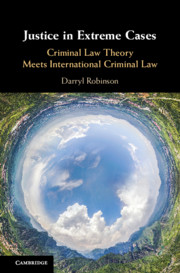Book contents
- Justice in Extreme Cases
- Justice in Extreme Cases
- Copyright page
- Contents
- Acknowledgements
- Cases, Statutes, and Other Authorities
- Abbreviations
- Part I Introduction and Problem
- Part II Proposed Solution: A Humanist, Coherentist, Deontic Account
- Part III Illustration through Application
- 6 An Unresolved Contradiction
- 7 The Outer Limits of Culpability
- 8 The Genius of Command Responsibility
- 9 Horizons: The Future of the Justice Conversation
- Book part
- Glossary of Selected Terms
- Bibliography
- Index
7 - The Outer Limits of Culpability
from Part III - Illustration through Application
Published online by Cambridge University Press: 17 December 2020
- Justice in Extreme Cases
- Justice in Extreme Cases
- Copyright page
- Contents
- Acknowledgements
- Cases, Statutes, and Other Authorities
- Abbreviations
- Part I Introduction and Problem
- Part II Proposed Solution: A Humanist, Coherentist, Deontic Account
- Part III Illustration through Application
- 6 An Unresolved Contradiction
- 7 The Outer Limits of Culpability
- 8 The Genius of Command Responsibility
- 9 Horizons: The Future of the Justice Conversation
- Book part
- Glossary of Selected Terms
- Bibliography
- Index
Summary
In this chapter, I move on to resulting normative questions about the culpability principle, causal contribution, and command responsibility. I engage in deontic analysis of what type of contribution the culpability principle actually requires, and whether the requirement might be reconceived.
First, I will examine why criminal law requires causal contribution, and the degree of contribution required. I will argue that the requirement in relation to accessories is not onerous; ‘risk aggravation’ satisfies the culpability principle.
Second, I consider ambitious proposals to re-imagine culpability, i.e. to develop a new deontic account that does not require any causal contribution. A theme of this book is that ICL can present us with new questions that can lead us to adjust our basic assumptions from criminal law theory. On this issue, however, although the arguments are intriguing, my conclusion is that on a coherentist all-things-considered judgement, they are as yet far too tentative and undeveloped to provide a convincing basis for criminal sanctions. Accordingly, the current best theory is that accessories must at least elevate the risk of the crimes occurring.
Keywords
- Type
- Chapter
- Information
- Justice in Extreme CasesCriminal Law Theory Meets International Criminal Law, pp. 177 - 193Publisher: Cambridge University PressPrint publication year: 2020

